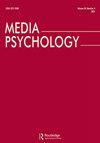我帮你,你帮我:情景喜剧中的跨种族互惠影响种族态度
IF 2.6
2区 心理学
Q1 COMMUNICATION
引用次数: 0
摘要
在这篇论文中,三项研究考察了观看情景喜剧对美国黑人态度的影响。研究1是对以黑人演员(PBC)或白人演员(PWC)为主的情景喜剧的内容分析,并展示了种族间的互动。研究发现,积极的跨种族互动(跨种族互惠)在两种类型的节目中都存在,但在PBC情景喜剧中更为常见。研究二是一项调查,发现观看PBC情景喜剧与减少偏见有关,而观看PWC情景喜剧与增加偏见有关。这些效应是由美国黑人的积极互惠期望介导的,正如有限广义互惠理论所解释的那样。研究3是一项实验,通过降低消极互惠期望的机制,发现在PBC中接触更多的种族间互惠场景与对美国黑人的消极态度减少有关。总的来说,我们发现情景喜剧与激活种族偏见有关。然而,这些信念的走向在一定程度上取决于这些节目的演员主要是黑人还是白人。披露声明作者未报告潜在的利益冲突。研究1中样本选择的更多细节可以在OSF上找到:https://osf.io/48swm/?view_only=d319459fa64d48eab6427010777de3b4.2。之所以做出这一决定,是因为有研究表明,在媒体中跨种族互动的替代学习背景下,种族和民族身份很重要(Kim & Harwood, Citation2020)。除了白人之外,报告每种种族身份的参与者人数很少,因此很难从统计上得出关于这些群体的准确结论。我们选择将其从分析中删除,而不是对具有这些种族和民族身份的个人做出未经证实的断言。在两项涉及人类受试者的研究(研究2和研究3)中,仅包括那些被认定为白人的人与包括所有样本中的人相比,对结果的解释没有实质性差异。研究1的内容分析用于选择研究3的节目;这些节目是该内容分析中唯一提供了0、2和5个种族间互惠实例的剧集。没有其他节目的组合允许我们精确地改变互惠实例的数量,同时仍然可以操纵黑白投射和黑白类别中的多个节目的刺激采样。因此,选择使用这些节目是实际和必要的。未来的研究可能希望确定更多的当前节目是否会有类似的效果。为了概念清晰,互惠操作被视为本分析的连续预测因子。然而,也运行了一个版本,其中它被视为一个多分类变量,以确认结果的模式。在这种情况下,当比较5个互惠实例和0个互惠实例时,种族构成和互惠实例之间的相互作用在预测负互惠期望方面是显著的,b=-1.24, p = 0.02, 95% CI(- 2.28, - 0.20),但当比较2个互惠实例和0个互惠实例时,b=-0.59, p = 0.27, 95% CI(- 1.64, 0.46)。鉴于对这些相互作用的解释与使用连续版本时得出的结论相同(当互惠性高时,投射种族构成存在显著差异,但当互惠性低或为零时则不存在显著差异,并且在任何投射种族构成条件下,互惠性都没有显著的简单主效应),我们在主要文本中报告了更简洁的-如果不太理想的统计假设-连续版本,并将该版本用于有调节的中介模型和间接效应测试。本文章由计算机程序翻译,如有差异,请以英文原文为准。
I Help You, You Help Me: Interracial Reciprocity in Situation Comedies Influences Racial Attitudes
ABSTRACTIn this manuscript, three studies examined the effects of viewing situation comedies on attitudes toward Black Americans. Study 1 was a content analysis of sitcoms that had either predominately Black casts (PBC) or predominately White casts (PWC) and showcased interracial interaction. It is found that positive cross-racial interaction (interracial reciprocity) occurs in both types of shows but is more common with PBC sitcoms. Study 2 was a survey that found watching PBC sitcoms was associated with reduced prejudice, while watching PWC sitcoms was associated with increased prejudice. These effects were mediated by positive reciprocity expectations for Black Americans, as explicated by Bounded Generalized Reciprocity theory. Study 3 was an experiment that found exposure to increased scenes of interracial reciprocity in PBC was associated with less negative attitudes toward Black Americans through the mechanism of reduced negative reciprocity expectations. Overall, we found sitcoms are associated with activating racial prejudice. However, the direction of these beliefs is in part determined by if the casts of these shows are predominantly Black or White. Disclosure statementNo potential conflict of interest was reported by the authors.Notes1. More details for the sample selection in Study 1 can be found on OSF: https://osf.io/48swm/?view_only=d319459fa64d48eab6427010777de3b4.2. This decision was made due to research suggesting that racial and ethnic identity matter in the context of vicarious learning from interracial interaction in media (Kim & Harwood, Citation2020). The small number of participants reporting each racial identity aside from White made it difficult to statistically draw accurate conclusions about those groups. Rather than make unsubstantiated claims about individuals with those racial and ethnic identities, we opted to remove them from analysis. There were no substantive differences in the interpretation of results when only those who identified as White were included compared to when all people in the sample were included, across both studies with human subjects (Study 2 and Study 3).3. Our content analysis from Study 1 was used to choose the shows for Study 3; these shows were the only ones from that content analysis that all provided episodes with 0, 2, and 5 interracial reciprocity instances. No other combinations of shows allowed us to vary the number of reciprocity instances with precision while still having the manipulation of Black and White casts and stimulus sampling of multiple shows within the Black/White categories. Therefore, the choice to use these shows was practical and necessary. Future research may wish to determine whether more current shows would have similar effects.4. For conceptual clarity, the reciprocity manipulation is treated as a continuous predictor for this analysis. However, a version was also run where it was treated as a multicategorical variable in order to confirm the pattern of results. When this is the case, the interaction between cast racial composition and reciprocity instances is significant in predicting negative reciprocity expectations when comparing 5 reciprocity instances to 0 reciprocity instances, b=-1.24, p = .02, 95% CI(−2.28, −0.20), but not when comparing 2 reciprocity instances to 0 reciprocity instances, b=-0.59, p = .27, 95% CI(−1.64, 0.46). Given that the interpretation of these interactions leads to the same conclusions as when the continuous version is used (that there is a significant difference by cast racial composition when reciprocity is high, but not when reciprocity is low or zero, and there is no significant simple main effect of reciprocity in either cast racial composition condition), we report the more parsimonious – if less ideal for statistical assumptions – continuous version in the main text and use that version for the moderated mediation model and indirect effects testing.
求助全文
通过发布文献求助,成功后即可免费获取论文全文。
去求助
来源期刊

Media Psychology
Multiple-
CiteScore
8.60
自引率
7.10%
发文量
30
期刊介绍:
Media Psychology is an interdisciplinary journal devoted to publishing theoretically-oriented empirical research that is at the intersection of psychology and media communication. These topics include media uses, processes, and effects. Such research is already well represented in mainstream journals in psychology and communication, but its publication is dispersed across many sources. Therefore, scholars working on common issues and problems in various disciplines often cannot fully utilize the contributions of kindred spirits in cognate disciplines.
 求助内容:
求助内容: 应助结果提醒方式:
应助结果提醒方式:


